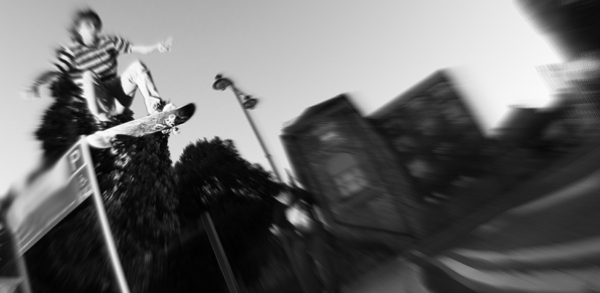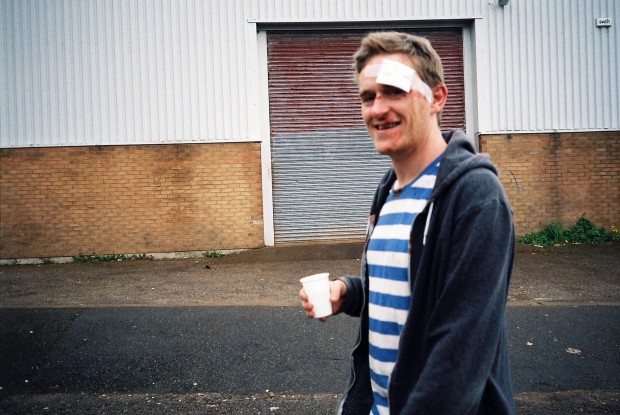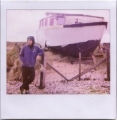You have no items in your cart. Want to get some nice things?
Go shoppingIn the first of two essays, Dave Beven sees the urban landscape of Nottingham through the eyes of a skateboarder.

I know you’ve heard it’s over now and war must surely come. The cities, they are broke in half and the middlemen are gone. But let me ask you one more time, oh children of the dusk. All these hunters who are shrieking now, oh do they speak for us? —“Stories of the Street” by Leonard Cohen
Invisibility
I saw Sketchy Steve come loping across the Old Market Square from a mile away, all gangly limbs and toothless smile. It was the fourth time our paths had crossed that day. With each crossing Steve had grown increasingly booze-riddled, proclaiming, at an ever-increasing volume, that he was all the more sober and thus, all the more worthy of our pennies. He sat with us for a spell on the blocks that surround the square, chewing the fat, telling of his past as a member of our clan and his prowess upon the holy board. Man, if Steve could skate anywhere near as well as he could spin a yarn, he must have been lord and master of the early nineties skateboarding scene.
We didn’t go out of our way to hang out with Sketchy Steve, nor any of the other loners, vagrants, wanderers and weirdoes who populate the fabric of Nottingham city. But we didn’t shun them either, as the vast majority do. When you spend as much time skating the public spaces and forgotten corners of the city, along with all the other tweakers and lurkers, then it’s just easier for all involved to get along.
I liked Steve and those others. Once you get past the sometimes dubious intent and noxious smell, they were folk the same as anyone else. I never begrudged the time spent listening to their rambling tales, nor the loose change spared for some relief from their days. Before Steve left his perch amongst us for another pitch somewhere across town, I noticed the looks that passers-by were shooting at us; scornful, apprehensive and fleeting, before their gaze would return to fix unwaveringly on their destination, be it bus-stop, fast food outlet or shopping precinct.
Streams of people flowed left and right, never diverting from their course, as if their route was etched into the stone they swarmed over. No one appeared to notice the line of five drain covers in a row that send you flying if they catch you unawares when riding on four small wheels, or the curved plant pots, crumbling and blackened from the grind of past conquests and failures. No one looked up at the beautiful architecture of the city’s rooftops and chimneys, observing all from above, silent, forgotten and majestic.
This is one of the main skateboarding haunts in the city centre, almost always populated by at least a handful of rolling figures. The passers-by might feel familiar jolt of unease at the sound of clanking trucks and wood scraping on concrete, but they had no concept of what our purpose was, no recognition of our place within these shared surroundings. We became like the planters and ledges, dirty, broken but largely invisible.
The Importance of Style
Back when I first learned to flop up kerbs and ride down my mum’s street without falling off, skateboarding was the be-all-and-end-all; an all-encompassing fog that influenced my every movement, and the way I viewed the world.
Even now, I can’t walk anywhere without taking note of slanted kerb-cuts, the patterns in broken paving slabs and the slightest wall-ride opportunity. Back then, though, it was inescapable. I’d notice a scuffed skate shoe from twenty paces and recognise with religious vigour the most discrete skate logo nestled upon a stranger’s hooded top. I could reel off every rider and particular of the company in question without stopping to draw breath. It was a gradual and baffling initiation into a secret gang, comprised of mystics, vandals and sacred key-holders.
These days, skate companies have become fair game for the high street. You’re no longer so likely to get heckled for rocking knackered skate plimsolls or weird tee-shirts with aliens or defecating cartoon animals emblazoned across them. (Although saying that, I did get the old “hey duuuuuudddde, radical bro” line from some poncy student the other day, who was ironically decked out in DVS and Carhart gear.)
But the importance of a loose sub-cultural uniform still stands true. Skateboarding is an increasingly broad church, admittedly, but seeing a stranger bomb past on a skateboard, wearing instantly recognisable wares with an air of speed, control and style is still enough to make me dash home for my plank and abandon my plans to go rolling.
French novelist, playwright, petty criminal and all-round amazing rabble-rouser Jean Genet was on a similar trip. In The Thief’s Journal he exalts a tube of Vaseline that is discovered upon his person during one of the frequent police raids he suffers. The significance of such a mundane object? For Jenet, it is everything; a cultural signifier and beacon of his homosexuality, as blatant and unrepentant as the thief himself. One man’s industrial lubricant is another’s defining sexual statement. One man’s ripped shoe is the symbol of another’s whole lifestyle
I’m Loving Angels Instead

I’d not even attempted to skate for nigh-on a week. Two hill-bomb mishaps within two days had rendered my wrists useless and limp, bloodied my palms and killed off any will or love for the wooden plank. Skateboarding is still an unavoidable part of my days, but maybe no longer the be-all-and-end-all. Besides, the weather had turned real crappy as of late … and other such excuses.
Another day rolled by, and as the evening lowered herself over the city I became increasingly restless. I still had little will to hurl myself over the unforgiving terrain of the wet streets, but the need to get out and about into the world and her curves was strong. When a good friend called to see if I fancied going down to a local undercover spot to add a block to our fledgling attempt at a local Burnside, I near enough jumped at the chance.
We drove around in the damp dusk, liberating breezeblocks, bags of cement, sand and other such necessary ingredients from vacated building sites, before heading down to the lurker’s paradise that is Beeston Train Station. All was quiet under the bridge; the icy drizzle had kept the teenage drinkers away and the only noise was from the Working Men’s Club a couple of streets away, deep in the drama of the Friday night disco.
We set to work under the cover of darkness and the fly-over, mixing, cementing, lifting, swearing and laughing at our novice labouring techniques. We didn’t really know what we were doing, but the wallride we’d built some months earlier was still standing and the thought of the increased potential for block-then-wall related lines spurred us on toward sloppy completion.
We were adding the finishing touches to our cinderblock as last orders chimed and the patrons spilled out from the dance floor of the W.M.C onto the pavement. We silently finished smoothing the block and swept up as the social club locals drifted across the bridge overhead, screaming lusty accusations at each other between renditions of Robbie Williams, football chants and disco classics.
As the broken glass rained down from on high and fully grown men offered up I’m Loving Angels Instead to the gods of alcohol and violence, I perched upon Beeston’s newest spot and thanked those very same gods dearly, for skateboarding.

About Dave Bevan
Dave Bevan is 29 years old. He digs holes and cuts trees to earn a wage, and writes, skateboards, falls off motorbikes, and day-dreams the rest of the time.




Great #EssaySaturday from Dave Bevan on skateboarding urban spaces. “Stories of the Street: Skateboarding the City” https://t.co/CmXo4i2h
#skateboarding the city – interesting essay on skateboarders sharing and altering urban spaces @LitroMagazine https://t.co/j6lVaiOh
Interesting essay on skateboarding and changing urban landscapes @LitroMagazine https://t.co/kOpmp9mg
Refreshing and thoughtful essay from Dave Bevan on skate culture in an English city. Good stuff, give it a read. https://t.co/OMRbbCm4
@therealhough Refreshing, thoughtful essay on skate culture in an English city. Good stuff, give it a read. https://t.co/pxcLS75u
It’s really a great and helpful piece of info.
I’m satisfied that you just shared this useful info with us.
Plewase keep us informed like this. Thank you for sharing.